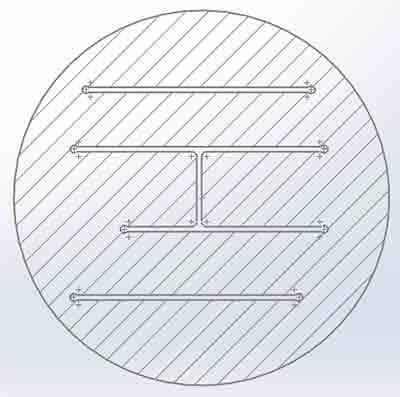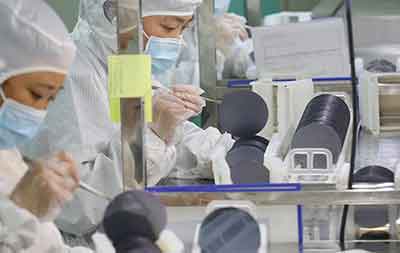It’s a simple design, I just want to know the cost. For now, I am sending you the sample design drawing , I would like to know the cost for 1 piece so that I can fix how many would I be able to afford.
Preparing Su-8 Wafers for Microchip Fabrication
A postdoctoral research scholar requested a quote for the following.
I'm looking to find a company that can offer Su-8 wafer fabrication using photolithography, 75 mm diameter. I've prepared some designs for channels to be used for PDMS microchip fabrication and i need a baked lithographic SU8 wafer for it. Does your company provide service to prepare SU8 wafer for given design, the height of channels on wafer should be 35um. If so, can you provide me a quotation with price range and delivery time to my location?
UniversityWafer, Inc. Replied:
Yes, we have SU-8 wafer. 75mm diameter with 35um height of channels on wafers is OK. What is the quantity?Please send us the drawing.
Postdoc replied:

Reference #318561 for specs and pricing.
How Microchips Are Fabricated?
Microchips are very complex devices and can be hundreds of thousands of parts. They contain billions of linked and integrated transistors to create sophisticated circuits. A microchip's functionality is largely determined by the number of micro components. Advanced design tools are used to generate integrated circuit layouts and create the three-dimensional architecture of sandwich layers. These designs are then transferred onto silicon wafers and photomasks. These photomasks are used to manufacture electronic devices.
UniversityWafer, Inc. Supplies scientists with the substrates they need for their microchip research and production.
Get Your FAST! Or, Buy Online and Start Researching Today!
What are the Steps to Fabricate Microchips?
In order to produce a chip, different materials are used. The first step is to create a photomask. These  photomasks are like picture templates that allow a chip to have the same structure over again. To ensure the precision of the chip's design, these photomasks need to be manufactured in a dust-free environment and maintained at constant temperatures and humidity. This process is very delicate, and requires careful monitoring of the temperature and humidity.
photomasks are like picture templates that allow a chip to have the same structure over again. To ensure the precision of the chip's design, these photomasks need to be manufactured in a dust-free environment and maintained at constant temperatures and humidity. This process is very delicate, and requires careful monitoring of the temperature and humidity.
The next step in creating a chip is to create the photomasks. These are like picture templates that ensure that the same microchip structure is produced each time. To make the photomasks, they must be produced in a clean, sterile environment with constant temperature and humidity. Once these are complete, they are then fixed to a circuit board or electronic system. During the final step, the chips are assembled and tested.
The first step in the production of a microchip is to create a photomask. These are photomasks used as picture templates to ensure that the exact microchip structure is reproduced each time. The photomasks must be manufactured in a dust-free environment with constant humidity. A photomask has to be made in a clean, dry environment. These processes are also known as "masks".
The next step is to create the semiconductor chip. The photomasks serve as picture templates. The photomasks are used to duplicate the exact structure of a microchip. These photomasks must be made in a dust-free environment with constant temperature and humidity. When the semiconductor is complete, the chip will be fixed to a circuit board. Then, the chips will be tested for proper functionality.
The next step in the production of microchips is to create photomasks. These photomasks act as picture templates for the microchips. The purpose of these masks is to duplicate the exact structure of a chip. The photomasks are used as templates for the production of a chip. They must be manufactured in a dust-free environment with constant temperature and humidity. In addition, the chip must be in a constant position.
The process of microchip manufacturing is highly complex and highly automated. It involves printing hundreds of identical microchips onto thin layers of silicon. These layers may be millions of times smaller than the human eye and require many precise alignments. The process of microchip manufacturing is also subject to fluctuations in temperature and humidity. Despite the complexity of the process, the microchips are very small compared to other electronic components. The semiconductors are often manufactured on a micrometer scale.
The process of microchip production is complex and involves using a photomask as a picture template. It is used to produce the patterns that make the chip. This process requires a dust-free environment. A constant temperature and humidity are necessary to produce the correct image. To produce the chip, the layers must be precisely duplicated. This process can take years and involve many steps. When it is finished, the chip is called a'microchip' and contains billions of transistors.
The process of making a microchip is complex and involves several steps. The most important element is the photomask. The photomask is a picture template used to produce the microchip. It is the material that forms the pattern of a chip. It is then manufactured by a machine. To produce a chip, it is necessary to use complex equipment and a constant temperature. In order to produce a microchip, it must also be made in a dust-free environment.
Because semiconductors are complex and complexly built, it is difficult to make a single chip without the help of specialized equipment. A typical microchip is made up of many tiny layers of silicon. Its layer thickness is only a few millimeters thick, but it is incredibly dense. The memory chip will have the most dense layer. The memory will also be the highest density. Once it is made, it will be the first step in a microprocessor.
